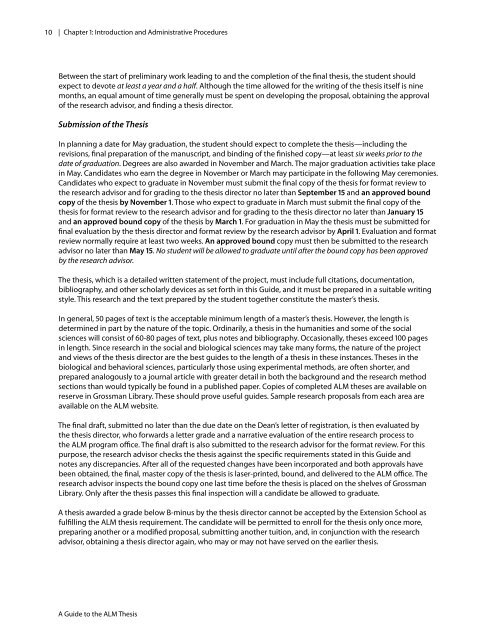A Guide to the ALM Thesis - iSites - Harvard University
A Guide to the ALM Thesis - iSites - Harvard University
A Guide to the ALM Thesis - iSites - Harvard University
You also want an ePaper? Increase the reach of your titles
YUMPU automatically turns print PDFs into web optimized ePapers that Google loves.
10<br />
| Chapter 1: Introduction and Administrative Procedures<br />
Between <strong>the</strong> start of preliminary work leading <strong>to</strong> and <strong>the</strong> completion of <strong>the</strong> final <strong>the</strong>sis, <strong>the</strong> student should<br />
expect <strong>to</strong> devote at least a year and a half. Although <strong>the</strong> time allowed for <strong>the</strong> writing of <strong>the</strong> <strong>the</strong>sis itself is nine<br />
months, an equal amount of time generally must be spent on developing <strong>the</strong> proposal, obtaining <strong>the</strong> approval<br />
of <strong>the</strong> research advisor, and finding a <strong>the</strong>sis direc<strong>to</strong>r.<br />
Submission of <strong>the</strong> <strong>Thesis</strong><br />
In planning a date for May graduation, <strong>the</strong> student should expect <strong>to</strong> complete <strong>the</strong> <strong>the</strong>sis—including <strong>the</strong><br />
revisions, final preparation of <strong>the</strong> manuscript, and binding of <strong>the</strong> finished copy—at least six weeks prior <strong>to</strong> <strong>the</strong><br />
date of graduation. Degrees are also awarded in November and March. The major graduation activities take place<br />
in May. Candidates who earn <strong>the</strong> degree in November or March may participate in <strong>the</strong> following May ceremonies.<br />
Candidates who expect <strong>to</strong> graduate in November must submit <strong>the</strong> final copy of <strong>the</strong> <strong>the</strong>sis for format review <strong>to</strong><br />
<strong>the</strong> research advisor and for grading <strong>to</strong> <strong>the</strong> <strong>the</strong>sis direc<strong>to</strong>r no later than September 15 and an approved bound<br />
copy of <strong>the</strong> <strong>the</strong>sis by November 1. Those who expect <strong>to</strong> graduate in March must submit <strong>the</strong> final copy of <strong>the</strong><br />
<strong>the</strong>sis for format review <strong>to</strong> <strong>the</strong> research advisor and for grading <strong>to</strong> <strong>the</strong> <strong>the</strong>sis direc<strong>to</strong>r no later than January 15<br />
and an approved bound copy of <strong>the</strong> <strong>the</strong>sis by March 1. For graduation in May <strong>the</strong> <strong>the</strong>sis must be submitted for<br />
final evaluation by <strong>the</strong> <strong>the</strong>sis direc<strong>to</strong>r and format review by <strong>the</strong> research advisor by April 1. Evaluation and format<br />
review normally require at least two weeks. An approved bound copy must <strong>the</strong>n be submitted <strong>to</strong> <strong>the</strong> research<br />
advisor no later than May 15. No student will be allowed <strong>to</strong> graduate until after <strong>the</strong> bound copy has been approved<br />
by <strong>the</strong> research advisor.<br />
The <strong>the</strong>sis, which is a detailed written statement of <strong>the</strong> project, must include full citations, documentation,<br />
bibliography, and o<strong>the</strong>r scholarly devices as set forth in this <strong>Guide</strong>, and it must be prepared in a suitable writing<br />
style. This research and <strong>the</strong> text prepared by <strong>the</strong> student <strong>to</strong>ge<strong>the</strong>r constitute <strong>the</strong> master’s <strong>the</strong>sis.<br />
In general, 50 pages of text is <strong>the</strong> acceptable minimum length of a master’s <strong>the</strong>sis. However, <strong>the</strong> length is<br />
determined in part by <strong>the</strong> nature of <strong>the</strong> <strong>to</strong>pic. Ordinarily, a <strong>the</strong>sis in <strong>the</strong> humanities and some of <strong>the</strong> social<br />
sciences will consist of 60-80 pages of text, plus notes and bibliography. Occasionally, <strong>the</strong>ses exceed 100 pages<br />
in length. Since research in <strong>the</strong> social and biological sciences may take many forms, <strong>the</strong> nature of <strong>the</strong> project<br />
and views of <strong>the</strong> <strong>the</strong>sis direc<strong>to</strong>r are <strong>the</strong> best guides <strong>to</strong> <strong>the</strong> length of a <strong>the</strong>sis in <strong>the</strong>se instances. Theses in <strong>the</strong><br />
biological and behavioral sciences, particularly those using experimental methods, are often shorter, and<br />
prepared analogously <strong>to</strong> a journal article with greater detail in both <strong>the</strong> background and <strong>the</strong> research method<br />
sections than would typically be found in a published paper. Copies of completed <strong>ALM</strong> <strong>the</strong>ses are available on<br />
reserve in Grossman Library. These should prove useful guides. Sample research proposals from each area are<br />
available on <strong>the</strong> <strong>ALM</strong> website.<br />
The final draft, submitted no later than <strong>the</strong> due date on <strong>the</strong> Dean’s letter of registration, is <strong>the</strong>n evaluated by<br />
<strong>the</strong> <strong>the</strong>sis direc<strong>to</strong>r, who forwards a letter grade and a narrative evaluation of <strong>the</strong> entire research process <strong>to</strong><br />
<strong>the</strong> <strong>ALM</strong> program office. The final draft is also submitted <strong>to</strong> <strong>the</strong> research advisor for <strong>the</strong> format review. For this<br />
purpose, <strong>the</strong> research advisor checks <strong>the</strong> <strong>the</strong>sis against <strong>the</strong> specific requirements stated in this <strong>Guide</strong> and<br />
notes any discrepancies. After all of <strong>the</strong> requested changes have been incorporated and both approvals have<br />
been obtained, <strong>the</strong> final, master copy of <strong>the</strong> <strong>the</strong>sis is laser-printed, bound, and delivered <strong>to</strong> <strong>the</strong> <strong>ALM</strong> office. The<br />
research advisor inspects <strong>the</strong> bound copy one last time before <strong>the</strong> <strong>the</strong>sis is placed on <strong>the</strong> shelves of Grossman<br />
Library. Only after <strong>the</strong> <strong>the</strong>sis passes this final inspection will a candidate be allowed <strong>to</strong> graduate.<br />
A <strong>the</strong>sis awarded a grade below B-minus by <strong>the</strong> <strong>the</strong>sis direc<strong>to</strong>r cannot be accepted by <strong>the</strong> Extension School as<br />
fulfilling <strong>the</strong> <strong>ALM</strong> <strong>the</strong>sis requirement. The candidate will be permitted <strong>to</strong> enroll for <strong>the</strong> <strong>the</strong>sis only once more,<br />
preparing ano<strong>the</strong>r or a modified proposal, submitting ano<strong>the</strong>r tuition, and, in conjunction with <strong>the</strong> research<br />
advisor, obtaining a <strong>the</strong>sis direc<strong>to</strong>r again, who may or may not have served on <strong>the</strong> earlier <strong>the</strong>sis.<br />
A <strong>Guide</strong> <strong>to</strong> <strong>the</strong> <strong>ALM</strong> <strong>Thesis</strong>

















